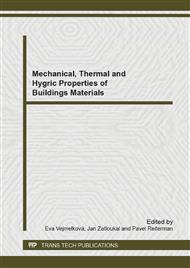p.1
p.6
p.11
p.16
p.22
p.27
p.32
p.38
Analysis of Thermal Conductivity of Lime Plaster with Pozzolanic Addition by Different Homogenization Techniques
Abstract:
Thermal conductivity of lime-pozzolan plaster is analyzed in the paper. At first, determination of basic physical properties of tested material is done for its basic characterization, as well as for the assessment of input parameters in the subsequent analysis of measured data by different homogenization techniques. The measurements of thermal conductivity are performed in dependence on moisture content from the dry state to the fully water saturated state using transient pulse method. Among the homogenization techniques based on effective media theory, Lichtenecker’s and Dobson’s models are used. The measured data presented in this paper can find utilization in practical applications of the studied plaster. The analyzed homogenization techniques are found to be applicable for a rapid evaluation of moisture dependent thermal conductivity.
Info:
Periodical:
Pages:
1-5
Citation:
Online since:
July 2014
Authors:
Price:
Сopyright:
© 2014 Trans Tech Publications Ltd. All Rights Reserved
Share:
Citation:


